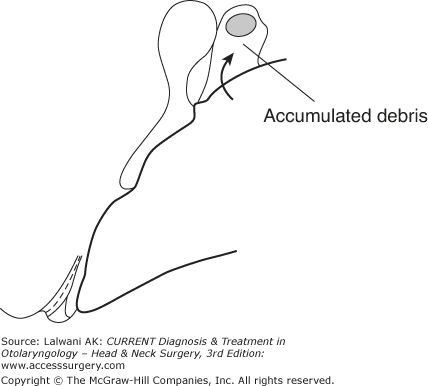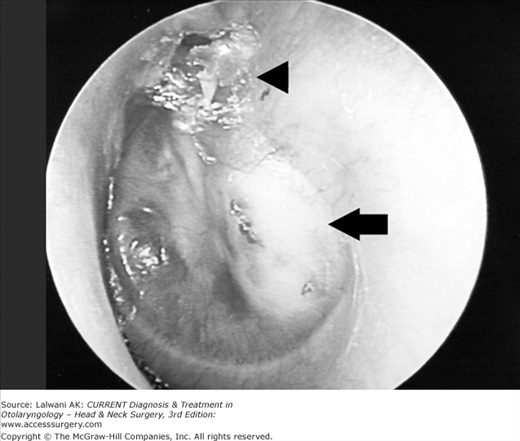Essentials of Diagnosis
- Squamous epithelium in the middle ear or mastoid
- Otorrhea and conductive hearing loss
- Retraction of the tympanic membrane with a squamous debris collection or a whitish mass behind an intact tympanic membrane
- Testing includes computed tomography (CT) scanning, which can be useful in delineating disease extent but is not critical to making a diagnosis in most cases
General Considerations
Cholesteatoma is the presence of squamous epithelium in the middle ear, mastoid, or epitympanum. The most common form of cholesteatoma is the acquired variety, which is classified as primary and secondary acquired cholesteatoma. Primary acquired cholesteatoma is the most common of these types and forms as a retraction of the tympanic membrane. In most cases, the retraction occurs in the pars flaccida, although pars tensa retractions can also occur (Figure 50–1). Secondary acquired cholesteatoma forms as a result of either squamous epithelial migration from the tympanic membrane or implantation of squamous epithelium into the middle ear during surgery, such as ventilation tube placement or tympanoplasty.
Cholesteatomas that occur without tympanic membrane retraction or implantation of squamous epithelial material are considered to be congenital in origin. This comprises a minority of cholesteatoma cases. It is classically defined as an embryonic rest of epithelial tissue in the ear without tympanic membrane perforation and without a history of ear infection. This definition has been modified in recent years, but essentially it is a condition typically seen in young children without evidence of the acquired type of cholesteatoma.
Pathogenesis
The pathogenesis of primary acquired cholesteatoma remains unclear. Factors that appear to be associated with formation of cholesteatoma retractions of the tympanic membrane include poor eustachian tube function and chronic inflammation of the middle ear, as in chronic otitis media. In theory, chronic negative middle ear pressure leads to retractions of the structurally weakest area of the tympanic membrane, the pars flaccida. Once the retractions form, the normal migratory pattern of the squamous epithelium is disrupted, resulting in the accumulation of keratin debris in the cholesteatoma sac. Chronic infection and inflammation ensue, leading to biochemical changes in the local environment that foster the further growth and migration of the squamous epithelium and increased osteoclastic activity, resulting in bone resorption. The local inflammatory response further inhibits eustachian tube function, increases mucosal edema and mucous secretion, and disrupts the drainage pathways of the temporal bone. This environment also fosters the growth of bacteria, including Pseudomonas aeruginosa, Streptococcus, Staphylococcus, Proteus, Enterobacter, and anaerobes, which increase the host’s inflammatory response and continue the cycle. It is not understood why only a small percentage of patients with poor eustachian tube function develop cholesteatoma and why some patients form pars tensa retractions rather than the more common pars flaccida retraction.
The pathogenesis of congenital cholesteatoma is unclear, but the most prevalent theory is the failure of involution of the epithelioid formation in the middle ear during fetal development. Other theories include metaplasia of the middle ear mucosa and, more recently, direct microretractions of the tympanic membrane near the malleus long process that are self-limited, but leave squamous epithelial rests in the middle ear.
Prevention
There are currently no known methods by which congenital cholesteatoma can be prevented. Secondary acquired cholesteatomas are often iatrogenic and therefore could theoretically be prevented if the surgeon takes all steps possible to prevent implantation of squamous epithelium into the middle ear.
Although the pathogenesis of primary acquired cholesteatoma is not clearly understood, if it is assumed that eustachian tube dysfunction is required for its formation, restoring eustachian tube function should help prevent the formation of this type of cholesteatoma. Unfortunately, there is no way to correct eustachian tube function directly. However, providing secondary ventilation to the middle ear space can reduce the complications related to poor eustachian tube function. This can be accomplished by inserting a ventilating tube. If early progressive tympanic membrane retractions are detected, this intervention could potentially prevent future progression of the disease to cholesteatoma. In addition, the successful control of infection and the inflammatory state of the middle ear, followed by regular débridement of the cholesteatoma sac in an office setting, can prevent future progression of the cholesteatoma in some cases.
Clinical Findings
Patients with acquired cholesteatomas typically present with recurrent or persistent purulent otorrhea and hearing loss. Tinnitus is also common. However, some patients with cholesteatoma may not develop otorrhea for a long period of time. In rare cases, vertigo or dysequilibrium can result from the inflammatory process in the middle ear or, in rare cases, from direct labyrinthine erosion by cholesteatoma. Facial nerve twitching, palsy, or paralysis can also result from the inflammatory process or from mechanical compression of the nerve.
Physical findings are usually diagnostic in cases of acquired cholesteatoma. In primary acquired cholesteatoma, there will be a retraction of the pars flaccida in most cases, and less commonly in the pars tensa (Figure 50–2). Both types of retractions contain a matrix of squamous epithelium, which may or may not be visible, and often keratin debris. Other typical findings include purulent otorrhea, polyps and granulation tissue, and ossicular erosion. In secondary acquired cholesteatoma, the findings depend on the cause. If the cholesteatoma developed from a tympanic membrane perforation, the squamous epithelial matrix, keratin debris, or both are usually visible through the perforation. If the cholesteatoma developed from either an implantation of squamous epithelium during surgery or a perforation that has closed, the tympanic membrane may in fact appear relatively normal. Once the middle ear cholesteatoma has enlarged to a sufficient size, it becomes visible behind the tympanic membrane. In patients whose tympanic membrane is opaque, further studies, such as imaging, may be required.
Congenital cholesteatomas are usually asymptomatic until the mass grows to a sufficient size that the ossicular chain function becomes disrupted and hearing loss develops. In many cases, the cholesteatoma is noted on the routine ear examination of an asymptomatic child.
In all cases, cranial nerve function, especially that of the facial nerve (CN VII), should be examined. In addition, an office evaluation for nystagmus and balance function should be considered in patients who have any evidence of vestibular dysfunction. A fistula test can be performed, but it has a low sensitivity in detecting labyrinthine fistula.
CT can be performed to delineate the extent of disease. Bone window axial and coronal cuts of 1.5-mm slices or less are ideal. It should be understood that a CT scan usually cannot make a definitive diagnosis regarding the nature of any existing temporal bone disease. CT findings that are suggestive of the presence of cholesteatoma include the erosion of bone, most commonly the scutum and ossicular chain (Figure 50–3). The presence of erosion of the labyrinth is highly suggestive of the presence of cholesteatoma, although neoplasms can also cause this finding. CT scanning cannot differentiate between fluid and tissue and, in particular, cannot distinguish between tissue types. The presence of fluid or soft tissue density in the middle ear and mastoid could indicate the presence of mucus, pus, inflammatory tissue such as granulations or polyps, thickened mucosa, cholesteatoma, neoplasm, encephalocele, or other conditions.





